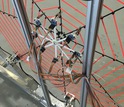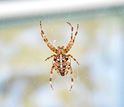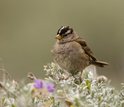Hola amigos: A VUELO DE UN QUINDE EL BLOG., Consideremos, por un momento, la humilde mosca de la fruta. Género Drosophila. Bulbosa de ojos y parecida al papel de alas, que es la plaga que ha aplastado lejos de ensalada de frutas y maldito en su cocina.
En el mundo científico, Drosophila es todo menos humilde; En su lugar, sirve como un organismo modelo de proporciones casa de máquinas. Durante más de un siglo, los científicos han utilizado Drosophila para revelar información acerca de la genética y desarrollo biológico. Múltiples descubrimientos ganadores del Premio Nobel de Drosophila participan de la investigación. Hoy en día, los científicos utilizan las moscas para comprender mejor de todo, desde las complejidades de la conducta social a la selección sexual.
En el mundo científico, Drosophila es todo menos humilde; En su lugar, sirve como un organismo modelo de proporciones casa de máquinas. Durante más de un siglo, los científicos han utilizado Drosophila para revelar información acerca de la genética y desarrollo biológico. Múltiples descubrimientos ganadores del Premio Nobel de Drosophila participan de la investigación. Hoy en día, los científicos utilizan las moscas para comprender mejor de todo, desde las complejidades de la conducta social a la selección sexual.
More information...........
Simple creatures reveal fundamental biological insights
 Credit and Larger Version |
April 21, 2016
Consider, for a moment, the humble fruit fly. Genus Drosophila. Bulbous-eyed and papery-winged, it's the pest you've swatted away from fruit salad and cursed at in your kitchen.
In the scientific world, Drosophila is anything but humble; instead, it serves as a model organism of powerhouse proportions. For over a century, scientists have used Drosophila to reveal insights about genetics and biological development. Multiple Nobel Prize-winning discoveries involved Drosophila research. Today, scientists use the flies to better understand everything from the complexities of social behavior to sexual selection.
"Model organisms are vital for biological research," says Robert Miller, a deputy division director in the National Science Foundation's (NSF) Biological Sciences Directorate. "They allow us to explore fundamental biological processes -- the rules of life universal to all organisms. We can then apply this knowledge to more and more complex species, such as humans."
All model organisms share a few common traits: they're inexpensive, easy to care for, grow quickly and are relatively simple creatures. Other than Drosophila, research stalwarts include the mustard plant Arabidopsis, the zebra fish and Saccharomyces cerevisiae (a particular strain of yeast).
Some researchers, however, are looking for additional creatures to help them explore new sets of biological challenges, from how our earliest ancestors first walked on land to the chemistry of our nervous system.
"You can think of animals as the product of a long history of experiments in nature," says Sandy Kawano, a postdoctoral researcher at the NSF-funded National Institute for Mathematical and Biological Synthesis (NIMBIoS). "There are lots and lots of things we can learn from them." And when researchers step outside the traditional model organism box, they often seek new approaches and ask new questions. "So Earth's diversity really does drive innovation."
Our earliest steps
When Kawano wanted to study the movements of the first tetrapods -- four-limbed vertebrates whose descendants include mammals -- she turned to the tiger salamander. Scientists believe the earliest vertebrates moved from water to land about 400 million years ago. Kawano and her team at NIMBIoS and Clemson University wanted to know the factors that drove changes in bone function as those animals became terrestrial. Tiger salamanders present a great stand-in for the prehistoric creatures, with a similar body and ecology.
Kawano filmed the salamanders strolling across a device that recorded the forces they exerted while walking. She combined that information with anatomical data, creating a mathematical model to calculate limb strength. Salamander forelimbs, she found, proved both stiffer and able to withstand higher loads than their hind limbs, meaning the front leg bones were stronger.
The study offered new insights into how form drives function in animal limbs, and shed slight on both the fossil record and prehistoric life on Earth.
Songs of the city
David Luther studies a more modern phenomenon: how animals adapt to urban environments. With NSF funding, the George Mason University biologist uses white-crowned sparrows to explore the ways cities, and particularly the human-generated noise within, change how birds communicate.
White-crowned sparrows work particularly well for such research because different subspecies produce distinctly different songs, making them ideal for research on animal communication.
"We want to know how and why animals are changing the way they communicate acoustically," Luther says. "Are they learning their songs? Is it a fixed sort of thing or is it a more plastic behavior?"
Luther and his collaborator, Elizabeth Derryberry of Tulane University, compared white-crowned sparrow song recordings from the 1960s to songs from today. They found the birds have changed the pitch of their song, likely to be heard over rush hour traffic. The birds also sing louder, just the way you would raise your voice when walking by a bustling construction site.
The researchers still don't know the exact consequences of this adaptation and how it affects the signals embedded in bird song. They have found that male birds singing at louder sites adjust their pitch accordingly, generating songs with lower vocal performance. This behavior makes them less successful at finding mates.
The study could have implications for how other species exist in urban settings.
"Most animals, whether it's a bird or something else, when they're presented with a lot of loud noise they just leave," Luther says. "But there are some animals that persist. If we find out how and why they're able to persist, we could apply this to other species as well."
Weaving a web
The squat European garden spider relies on vibrations to communicate, playing its own song, of sorts, on its web. This kind of communication may seem alien to humans, but vibrations serve as "one of the most common ways animals sense the world," says Damian Elias, a biologist and associate professor at University of California, Berkeley.
"By understanding it, we're really opening a window into how different life on Earth functions," he said.
With NSF funding, Elias has teamed up with Ross Hatton, an Oregon State University engineer, to probe the physics of spider web vibrations.
European garden spiders, common throughout Europe and North America, weave orb-style webs that serve as their entire sensory world. Complicated, yet delicate, these webs allow the spiders to distinguish between prey and predator, mate and foe.
Hatton has engineered a larger-than-life artificial spider web in his lab. The web is made of two materials -- nylon and elastic latex cords -- mimicking the two kinds of threads spiders use to build their webs. Hatton set the web in a sort of subwoofer frame, where speakers cause it to vibrate in different ways, the way real webs do. Artificial "spiders," eight-legged structures with accelerometers on each leg, allow Hatton to measure web vibrations at a fine scale.
Hatton's experiments feed into a computational model, which Elias tests in his lab with actual European garden spider webs. The setup helps answer a fundamental physics question -- how do strings that are bound together move -- using a real-world, eight-legged counterpart.
"It's tapping deep into all sorts of engineering and physics problems to really understand what's happening in the spider's world," Hatton says.
That understanding could extend to other spiders, shedding light on the behavior and ecology of one of Earth's most numerous animal groups.
Spider webs, like other biological structures, also represent pretty miraculous feats of engineering. They must be strong enough to withstand destructive impacts from predators, inviting enough to snag prey and flexible enough to survive in an elastic environment.
The research could lead to biological inspiration for new materials or structures, Elias said. "That's one of the nice things about basic research. The sky's the limit."
| -- | Jessica Arriens, (703) 292-2243 jarriens@nsf.gov |
Investigators Louis Gross
Ross Hatton
Damian Elias
David Luther
Colleen Jonsson
Elizabeth Derryberry
Ross Hatton
Damian Elias
David Luther
Colleen Jonsson
Elizabeth Derryberry
Related Institutions/Organizations Tulane University
George Mason University
Oregon State University
University of California-Berkeley
University of Tennessee Knoxville
Related Awards #1300426 NIMBioS: National Institute for Mathematical and Biological Synthesis George Mason University
Oregon State University
University of California-Berkeley
University of Tennessee Knoxville
#1504428 Collaborative Research: Spider Web Vibrations -- Active and Passive Detection
#1504459 Collaborative Research: Spider Web Vibrations -- Active and Passive Detection
#1354756 Collaborative Research: Urban-dependent selection on bird song: proximate and ultimate causes, and evolutionary consequences
#1354763 Collaborative Research: Urban-dependent selection on bird song: proximate and ultimate causes, and evolutionary consequences

An artificial spider web, engineered by Ross Hatton of Oregon State University.
Credit and Larger Version

A European garden spider.
Credit and Larger Version

George Mason University biologist David Luther in the field, recording white-crowned sparrow songs.
Credit and Larger Version

A white-crowned sparrow.
Credit and Larger Versión
the National Science Foundation's (NSF)
Guillermo Gonzalo Sánchez Achutegui
ayabaca@gmail.com
ayabaca@yahoo.com
ayabaca@hotmail.com
Inscríbete en el Foro del blog y participa : A Vuelo De Un Quinde - El Foro!

No hay comentarios:
Publicar un comentario